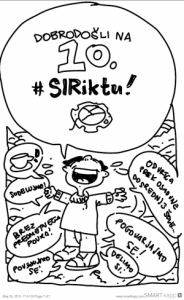Aleksandra Vadnjal in Mojca Stergar, OŠ Dekani
This article presents a self-study of mandalas by talented pupils. Later on, they also led their classmates during the lessons to explore mathematics behind mandalas. The combination of different colours, geometric shapes and patterns of mandalas has always fascinated human beings. They are present in everyday life – they are around us and copy natural patterns and shapes, for example a sunflower, a daffodil, a pine cone, sliced fruit, a cut trunk, universe, a snowflake etc. Behind them, there is also a lot of mathematics: geometric shapes, symmetrical patterns, bisectors; they are created through transformations (translations, rotations, reflections) etc. Mandalas and their features were explored by talented pupils. Firstly, they recognized mandalas in nature, then they coloured and observed mandalas drawn on paper, and after that they coloured and explored them using tablets. They used their knowledge acquired independently through observation and colouring to create their own mandalas in a tablet application. Finally, they tried to draw simple mandalas using geometric tools. Talented pupils presented mandalas also to their classmates and guided them to explore mathematics behind them. Colouring and observation of mandalas stimulates left and right hemisphere function. Pupils paid attention to their emotions, they stimulated their creativity as well as used their mind and logical thinking. By creating and exploring mandalas, they developed and strengthened their own creativity; some mandalas made them calm and relaxed, while the other ones made them more focused, and thus they improved and developed concentration for work. They developed through their drawings critical thinking and self-confidence as well. Problem education approach brought additional value to the lessons, since all pupils were active (affecting their memorising abilities, recall and synthesized knowledge). Moreover, they also took their own responsibility for their learning and knowledge since they had to come to certain laws and findings alone or through cooperative learning.
